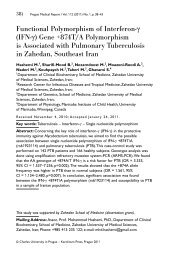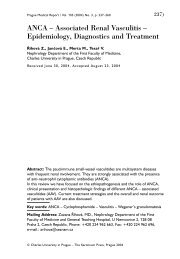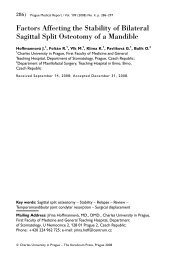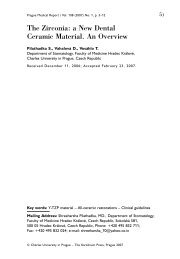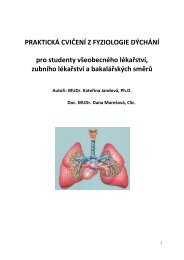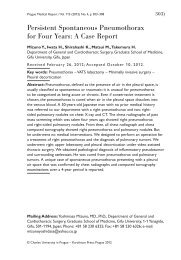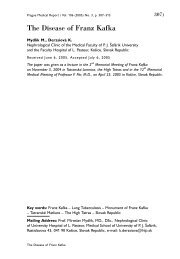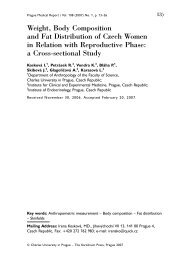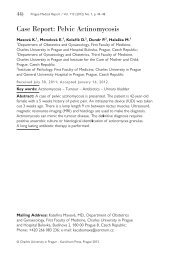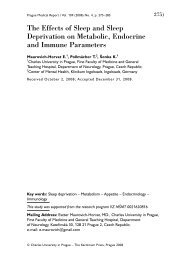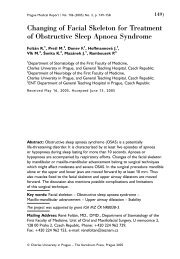HERE - Prague Medical Report
HERE - Prague Medical Report
HERE - Prague Medical Report
You also want an ePaper? Increase the reach of your titles
YUMPU automatically turns print PDFs into web optimized ePapers that Google loves.
<strong>Prague</strong> <strong>Medical</strong> <strong>Report</strong> / Vol. 105 (2004) No. 2, p. 131–140<br />
131)<br />
Electrocardiographic Body Surface Maps<br />
(BSM) in Patients with Ischemic Heart<br />
Disease Examined by Coronary Angiography<br />
Valouch P. 1 , Slavíček J. 2 , Tichý J. A. 1 , Peterka Z. 3 ,<br />
Kittnar O. 2, Trojan S. 2 , Trefný Z. 1 , Novák V. 2<br />
1<br />
Institute of Civilization Diseases,<br />
2 Institute of Physiology of the First <strong>Medical</strong> Faculty, Charles University in <strong>Prague</strong>,<br />
3 Central Military Hospital, <strong>Prague</strong>, Czech Republic<br />
Abstract: ECG body surface maps (BSM) is one of the noninvasive methods for<br />
the detection of ischemic heart disease. In the present work we registered<br />
the BSM in 25 patients, 18 men, mean age 56.8 (31–83) years, 7 women, mean<br />
age 58.7 (43–72) years with coronary artery disease and in 23 healthy persons,<br />
17 men, mean age 55 (46–60) years, 6 women, mean age 57 (42–70) years.<br />
Using diagnostic system Cardiag we measured 32 parameters of heart electric<br />
field (ECG, VCG, isopotential, isointegral, and isoarea maps). The results of BSM<br />
examination were compared with the results of coronary angiography (CAG)<br />
and other noninvasive methods. Twenty-four patients were BSM positive, 5 of<br />
them with negative CAG. In one case both BSM and CAG were negative. None<br />
of persons with positive CAG were BSM negative. The values of positive BSM<br />
in patients with negative CAG approached more to the values of positive CAG<br />
persons than to controls. Despite of small number of persons examined in our<br />
study one can conclude that the BSM method detects the damage of<br />
myocardium by another way than the CAG.<br />
Key words: ECG – VCG – body surface maps-ischemic heart disease<br />
– coronary angiography<br />
Supported by grants No. 106/94/1554 and 106/96/1584 Grant Agency<br />
of Czech Republic.<br />
Mailing address: Jaroslav Slavíček, MD., Ph.D., Institute of Physiology of the First<br />
<strong>Medical</strong> Faculty, Charles University, Albertov 5, 128 00, <strong>Prague</strong> 2, Czech Republic,<br />
Phone: +420 224 968 435, Fax: +420 224 918 816,<br />
e-mail: jaroslav.slavicek@lf1.cuni.cz<br />
© Charles University in <strong>Prague</strong> – The Karolinum Press, <strong>Prague</strong> 2004
132) <strong>Prague</strong> <strong>Medical</strong> <strong>Report</strong> / Vol. 105 (2004) No. 2, p. 131–140<br />
Introduction<br />
Recording of ECG body surface maps (BSM) is one of the possible noninvasive<br />
detection of coronary heart disease (CHD) [1]. The ECG stress test and coronary<br />
angiogram (CAG) records reviewed in 435 patients with chest pain showed<br />
44 cases with normal CAG (false positive exercise test) and 33 cases with both<br />
CAG and stress test negative. The left ventricular hypertrophy (LVH), history of<br />
hypertension or diabetes mellitus was the main factors influencing ECG stress test<br />
for detecting CHD [2].<br />
In the present work we measured by the method of BSM 25 patients with angina<br />
syndrome the diagnosis of them being supported by the abnormality of stress ECG<br />
test, radionuclide imaging, echocardiography, biochemical parameters (creatin<br />
phosphokinase, troponins) and examined by CAG with the aim to ascertain<br />
if the BSM method is more precise than the classic ECG in the detection of CHD<br />
[3–5]. The ECG, vectorcardiogram (VCG) and BSM registered at the same time by<br />
the same analyser is capable to describe in detail the heart electric field changes<br />
[6–8]. The diagnostic system Cardiag 112.1 analyses 32 parameters of ECG, VCG<br />
and BSM. The BSM findings in 23 healthy controls of the same age (57 ± 12 years)<br />
were performed to verify the differences in heart electrical field parameters in<br />
patients [9–15].<br />
Methods<br />
In 25 patients, 18 men, mean age 56.8 (31–83) years, 7 women, mean age 58.7<br />
(43–72) years the cardiologic finding consisted of expressive angina pains. They<br />
were examined by ECG, stress ECG testing, spirometry, scintigraphy, and<br />
echocardiography. In 8 patients the hypertension was in anamnesis, but stabilized<br />
with the therapy in the time of the BSM and coronary angiography (CAG)<br />
examination. In one patient, the left ventricular hypertrophy (LVH) was ascertained<br />
by ECG and echocardiography. In the other patients the left ventricular mass was<br />
of normal value.<br />
The control group consisted of 23 healthy volunteers, 17 men, mean age 55<br />
(46–60) years, 6 women, mean age 57 (42–70) years. In both groups the ECG,<br />
VCG and BSM were performed by diagnostic system Cardiag 112.1 and 32<br />
parameters of heart electric field were evaluated independently to the clinical<br />
diagnosis and the CAG [16]. In the present work there are only the repolarization<br />
isopotential (RIPM), isointegral (RIIM), and isoarea (RIAM 35, RIAM 80) maps<br />
parameters shown, the maximum and minimum (extreme) of them being<br />
statistically different in patients in comparison with the controls. These parameters<br />
were found to be sensitive to the ischemic changes [17–19]. Also other<br />
parameters including ECG and VCG were evaluated according to the menu of<br />
diagnostic system.<br />
For the statistical comparison the patients were divided to two groups: CAG<br />
positive and negative, and compared with controls. The CAG positive patients<br />
Valouch P. et al.
<strong>Prague</strong> <strong>Medical</strong> <strong>Report</strong> / Vol. 105 (2004) No. 2, p. 131–140<br />
133)<br />
have been compared with the BSM positive ones to verify the positivity of BSM<br />
[16,17]. But in 5 CAG negative patients the BSM positivity has been observed.<br />
The diagnosis of CAG positive patients was unstable angina pectoris, patients after<br />
myocardial infarction, with metabolic syndrome, diabetes mellitus type II,<br />
dyslipoproteinemia. In all of them the BSM finding was positive.<br />
The results of examination in 5 BSM positive and CAG negative patients are<br />
described in detail.<br />
Patient No. 1: woman, 51 years, nontoxic goitre, obesity, dyspnea relieved after<br />
isosorbitdinitrate (Maycor), the exercise stress ECG testing incomplete for<br />
decreased efficiency and the ventricular extrasystoles, echocardiography negative,<br />
BSM ischemia in lateral wall of left ventricle.<br />
Patient No. 6: man, 31 years, hypertrophic cardiomyopathy, stabilized<br />
hypertension, obesity, dyspnea during exercise ECG stress test, echocardiography<br />
positive, ejection fraction 54%, in ECG left ventricular hypertrophy (LVH), BSM<br />
ischemia in lateral wall of left ventricle.<br />
Patient No. 7: woman, 65 years, hypertension, blood pressure compensated,<br />
the effort dyspnea decreased after verapamil (Isoptin), stress ECG test positive,<br />
BSM without ischemia, but only the irregular repolarization.<br />
Patient No. 14: woman, 43 years, hypertension, the blood pressure normalized<br />
by therapy, the effort angina, the positive stress ECG test, the negative<br />
echocardiography, BSM repeatedly examined, the irregular repolarization pattern<br />
improved.<br />
Patient No. 15: man, 58 years, hypertension improved by therapy, obesity,<br />
echocardiography – decreased kinetics of the left ventricle, in CAG the spasm of<br />
right coronary artery was observed. In BSM the ischemia in anterior, lateral and<br />
posterior wall of left ventricle was found.<br />
The results of BSM measuring were statistically evaluated with t-test for two<br />
independent groups.<br />
Results<br />
No signs of silent ischemia – ECG, VCG and BSM abnormalities – were found in<br />
the control group. The ECG repolarization isointegral map (RIIM) of the T wave is<br />
shown in Fig. 1 in control (upper part) and in patient with nontransmural<br />
posterolateral ischemia and fibrosis (lower part). The regular concentricity of<br />
isointegral lines in the electropositivity (grey colour) is present in the map of<br />
control person. The irregularities both in electropositivity and in electronegativity<br />
(white colour) are marked in the map of the patient showing an altered<br />
repolarization. The lateral profile of the maps shows the regularity of the T wave<br />
in control (upper part) and the irregularities in the patient. Moreover, in control<br />
there is the positivity in whole anterior and lateral thorax, while in patient<br />
the electronegativity in the lower part of thorax is marked proving the ischemia<br />
and fibrosis. The numbers in Fig. l show the maximum and minimum (extreme) in<br />
BSM in Ischemic Heart Disease
134) <strong>Prague</strong> <strong>Medical</strong> <strong>Report</strong> / Vol. 105 (2004) No. 2, p. 131–140<br />
Fig. 1 – Repolarization isointegral maps (T wave, RIIM) in control (50-year-old) man (upper two figures)<br />
and in 52-year-old man with nontransmural posterolateral fibrosis and myocardial ischemia (lower two<br />
figures) registered with diagnostic system Cardiag.<br />
The upper two figures in each pair there are the profile pictures of the planar map measured in 4 th<br />
intercostal space. The numbers are the absolute values of maximum and minimum in µVs x 0.01.<br />
The lower pictures show the electropositive (grey colour) and electronegative (white colour) values<br />
of integrals in T wave on the surface of thorax. Left half of figures – the front of thorax, the right halves<br />
– back of thorax. Sixteen electrodes are regularly localized on thorax at the five floors: fossa jugularis,<br />
2 nd , 4 th ,6 th intercostal space, the same distance beneath 6 th intercostal space. The distance of lines:<br />
2 µVs.<br />
Valouch P. et al.
<strong>Prague</strong> <strong>Medical</strong> <strong>Report</strong> / Vol. 105 (2004) No. 2, p. 131–140<br />
135)<br />
electropositivity and electronegativity on the surface of thorax in µVs × 0.01.<br />
The absolute values of maximum and minimum are higher in control than in<br />
patients showing the hypopolarization in the ischemic tissue. One can compute<br />
from the irregular decrease of maximum (extreme) the “valley” between two<br />
“hills”. The absolute value of it is 5 µVs (fibrosis).<br />
The localization of stenosis in the coronary arteries of patients according to<br />
the CAG is summarized in Tab. 1. The comparison of repolarization parameters of<br />
the heart electrical field measured by BSM method is shown in Tab. 2 in CAG<br />
negative and positive patients and in controls. Differences between CAG positive<br />
and negative patients (column N×P in Tab. 2) were not significant in all measured<br />
BSM parameters. Significant differences of these parameters were found between<br />
CAG negative and controls (column N×C) and CAG positive and controls (column<br />
P×C in Tab. 2). The other measured parameters didn’t differ and were not shown<br />
in Tab. 2.<br />
The relation of ECG and BSM positive repolarization changes and CAG positive<br />
and negative findings in the patients (number of patients) is marked in Tab. 3.<br />
In 24 patients the BSM positive finding confirmed the clinical examination. Five of<br />
them (4 women, 1 man) ie. 20% were CAG negative (for the more detailed<br />
description of them see Methods) including 1 woman with proven coronary<br />
vasospasm, but without degenerative changes in the coronary arteries. I one<br />
patient (woman, Tab. 3) with angina syndrome both the CAG and the BSM were<br />
negative. It is probably either false negativity, or the diagnosis ought to be verified<br />
by the measurement of troponin, myoglobin, or by other methods like magnetic<br />
resonance.<br />
The comparison of repolarization changes in the classic 12-leads ECG and in<br />
BSM showed positive ECG findings only in 10 patients from 19. The ECG positive<br />
(pathologic) changes in our patients were the negative T wave, the ST elevation<br />
higher than 1 mm. The non-specific ECG changes were the ST segment<br />
Table 1 – Localization of coronary stenosis in 25 patients<br />
with coronary heart disease (CHD)<br />
Coronarographic finding<br />
Number of persons<br />
Stenosis RIA 2<br />
Stenosis Rcx 2<br />
Stenosis ACD 2<br />
Stenosis Rdg 1<br />
Stenosis RIA + ACD 4<br />
Stenosis ACD + RCx 2<br />
Stenosis RIA + RCx 1<br />
Stenosis RIA + ACD + RCx 5<br />
Negative finding 6<br />
RIA – ramus interventricularis anterior of the arteria coronaria sinistra; RCx – ramus circumflexus;<br />
ACD – arteria coronaria dextra; Rdg – ramus diagonalis<br />
BSM in Ischemic Heart Disease
136) <strong>Prague</strong> <strong>Medical</strong> <strong>Report</strong> / Vol. 105 (2004) No. 2, p. 131–140<br />
denivelation (depression or elevation) lower than 1 mm, the decreased R wave<br />
height, and the T wave decreased amplitude. In 5 patients these changes were<br />
present but in 4 patients with CAG positive finding (stenosis in coronary arteries).<br />
The ECG finding was negative (Tab. 3). On the other hand, among the patients<br />
Table 2 – Comparison of maximum and minimum (extreme)<br />
in the repolarization isopotential (RIPM), isointegral (RIIM), and isoarea<br />
(RIAM) maps in patients with positive and negative coronarography,<br />
and in controls (left part)<br />
Coronarography Controls T-tests<br />
Negat. Posit. N×P N×C P×C<br />
Parameter Mean Mean Mean Probab. Probab. Probab.<br />
(s.d.) (s.d.) (s.d.) Signif. Signif. Signif.<br />
N=6 N=19 N=23<br />
RIPMmax 408.17 553.95 – 0.1725 – –<br />
(µV) (211.92) (223.55)<br />
RIPMmin –193.8 –283.5 – 0.2188 – –<br />
( µV) (118.0) (159.5)<br />
RIIMmax 51.4 54.7 10.28 0.7962 0.0172 0.0000<br />
( µVs) (28.6) (26.6) (3.68) * ****<br />
RIIMmin –30.6 –34.0 –3.44 0.7688 0.0489 0.0000<br />
( µVs) (25.7) (23.7) (1.06) * ****<br />
RIAMmax35 2.48 3.50 5.31 0.2006 0.0157 0.0150<br />
( µVs) (0.9) (1.7) (2.5) * *<br />
RIAMmin35 –3.41 –2.71 –2.11 0.5795 0.3805 0.3331<br />
( µVs) (3.25) (2.46) (0.95)<br />
RIAMmax80 6.38 9.95 1.53 0.1472 0.0028 0.0000<br />
( µVs) (2.14) (5.64) (0.70) ** ****<br />
RIAMmin80 –7.64 –6.78 –0.55 0.7845 0.0910 0.0003<br />
( µVs) (8.3) (6.8) (0.21) ***<br />
Mean ± standard deviation; n-number of persons. Right part – the statistical significance and comparison<br />
of t-tests; N×P – coronarography negative × positive patients; N×C – coronarography negative × controls;<br />
P×C – coronarography positive × controls. * p
<strong>Prague</strong> <strong>Medical</strong> <strong>Report</strong> / Vol. 105 (2004) No. 2, p. 131–140<br />
137)<br />
with negative CAG, the only ECG positive finding was present in the patient with<br />
coronary artery spasm. In two patients the non-specific ECG findings were<br />
present, while in 3 patients no repolarization changes were identified (Tab. 3).<br />
The comparison of the parameters in 12-leads ECG in controls and in patients<br />
with CAG examination is shown in Tab. 4. The prolongation in QT duration and<br />
the decrease in frontal QRS angle (semihorizontal position of the heart) were<br />
shown in the patients with CHD (p
138) <strong>Prague</strong> <strong>Medical</strong> <strong>Report</strong> / Vol. 105 (2004) No. 2, p. 131–140<br />
The comparison of repolarization parameters of heart electrical field in controls<br />
and in patients with negative CAG (Tab. 2, right part, column N×C) showed<br />
a lower difference than the comparison of controls and patients with the positive<br />
CAG (Tab. 2, right part, column P×C), in the absolute values of maximum<br />
and minimum in isointegral and isoarea maps. While in patients with positive CAG<br />
the changes in concentricity of potential lines were more pronounced, following<br />
the more “hills” and “valleys” (Fig. 1, lower part) in patients with CAG negative<br />
these changes were less pronounced. The more detailed description of maximum<br />
and minimum is marked in higher sensitivity of measurement and higher density<br />
of lines (the distance of isointegral lines 1 µVs, while in routine measurement<br />
the distance is 2 µVs). In the literature, the BSM method was used to analyse<br />
rather the localization than the absolute values of maximum and minimum in<br />
patients with CHD [3, 4, 19] and with LVH [5]. For this detection the specialized<br />
program and the departure and scatter maps of extreme are necessary<br />
to perform [5]. But in the routine measurement one has to do the conclusion from<br />
the measurement of one patient similarly as in classic ECG evaluation.<br />
From the former experiences one can support that the BSM positivity<br />
in comparison with the coronary angiographic method is not in the same relation<br />
[21–23]. The present work showed, that the BSM method sensitively evaluated<br />
changes in electrical activation and repolarization of myocardium, but on the other<br />
level, than the CAG. One can express a hypothesis that the patients with positive<br />
BSM method can suffer from the segmental or global heart failure, which is not<br />
possible to detect by CAG. The BSM positive changes can be related<br />
to the changes in arteriolo-capillary hemodynamics in systemic hypertension [25],<br />
but also to the damage of cell membranes and other effects which, unfortunately,<br />
escape to the exact detection (sonography, magnetic resonance spectrography,<br />
thermography, and the other methods). The microcirculation defects<br />
in myocardium cannot be detected by CAG method [1], which is also insufficient<br />
for the detection of degenerative changes in coronary arteries in comparison with<br />
the results of intravascular sonography or direct angioscopy [6]. The detection<br />
Table 4 – The heart rate, PQ, QRS, QT (ms) intervals and the QRS<br />
angle in the frontal plane (degrees) in 23 controls and in 25 patients<br />
with CHD examined by coronarography with the 12-lead ECG (the men<br />
and women examined together). Mean values ± standard deviations<br />
Controls (n=23) CHD (n=25) p<br />
Heart rate /min. 71±10 66±18 –<br />
PQ (ms) 142±18 160±20 –<br />
QRS (ms) 93.3±10 116±12 –<br />
QT (ms) 360±20 402±18
<strong>Prague</strong> <strong>Medical</strong> <strong>Report</strong> / Vol. 105 (2004) No. 2, p. 131–140<br />
139)<br />
of vasospasm doesn’t correlate in Prinzmetal angina including the ECG changes,<br />
which are manifested only in 3% of the cases. To precise the CAG in spasm<br />
it is convenient to observe the index of fraction flow by repeatedly measured<br />
intravenous pressure [9].<br />
The routine ECG and the changes of stress exercise ECG test have in CHD<br />
the important validity, which is of about 72–75%. From the contemporary<br />
noninvasive methods one ought to use the SPECT method and biochemical<br />
markers, but the BSM method is more precise than the routine ECG (Tab. 4)<br />
with the next perspective, which appraises the aetiology of BSM changes.<br />
In spite of these facts we are aware that the more-leads- ECG has only<br />
restricted possibilities in the clinical diagnosis of CHD. It is an auxiliary but valuable<br />
examination method [26].<br />
References<br />
1. MIRVIS D. M.:Current status of body surface electrocardiographic mapping. Circulation 1987, 75/4:<br />
684–688.<br />
2. ZHANG X., WANG X., LI L., GAO Y., CUI J.: An analysis of factors influencing electrocardiogram<br />
stress test for detecting coronary heart disease. Chin. Med. J. (Engl.) 1999, 112/2: 590–592.<br />
3. TONOOKA I., KUBOTA I., WATANABE Y. ET AL.: Isointegral analysis of body surface maps for the<br />
assessment of location and size of myocardial infarction. Amer. J. Cardiol. 1983, 52: 1174–1180.<br />
4. GREEN L. S., LUX R. L., HAWS C. W.: Detection and localization of coronary artery disease<br />
with body surface mapping in patients with normal electrocardiograms. Circulation 1987, 76/6:<br />
1297–1297.<br />
5. KORNREICH F., MONTAGUE T. J., RAUTAHARJU P., KAVADIS M., HORACEK M. B., TACCARDI B.:<br />
Diagnostic body surface potential map patterns in left ventricular hypertrophy during PQRST. Am. J.<br />
Cardiol. 1989, 63: 610–617.<br />
6. RUTTKAY-NEDECKY I.: Problems and perspectives of mapping the cardiac electric field. Physiol. Res.<br />
1993, 42: 69–71.<br />
7. STOJAN M., BOUDÍK F., CHARVÁT A.: The methodology of clinical analysis of electric heart field.<br />
Physiol. Res. 1993, 42: 85–90.<br />
8. KITTNAR O., ŠŤOVÍČEK P.: Contemporary body surface potential mapping in electrocardiology<br />
and its perspectives. Physiol. Res. 1993, 42: 141–143.<br />
9. LI D., LI C. Y., YONG A. C., KILPATRICK D.: Source of electrocardiographic ST changes in<br />
subendocardial ischemia. Circ. Res. 1998, 82/9: 957–970.<br />
10. FOX K. M., JONATHAN A., SELWYN A.: Significance of exercise induced ST segment elevation in<br />
patients with previous myocardial infarction. Br. Heart J. 1983, 49/1: 15–19.<br />
11. BIRNBAUM Y., SOLODKY A., HERZ J. ET AL.: Implications of inferior ST-segment depression in<br />
anterior acute myocardial infarction: electrocardiographic and angiographic correlation. Am. Heart J.,<br />
1994, 127/6: 1467–1473.<br />
12. WONG C. K., FREEDMAN S. B.: Precordial ST change and site of the infarct-related lesion in right<br />
coronary artery-related inferior wall acute myocardial infarction. Am. J. Cardiol. 1995, 75/14:<br />
942–943.<br />
13. MONTAGUE T. J., JOHNSTONE D. E., SPENCER C. A. ET AL.: Non-Q-wave acute myocardial<br />
infarction: body surface potential map and ventriculographic patterns. Am. J. Cardiol. 1986, 58/13:<br />
1173–1180.<br />
BSM in Ischemic Heart Disease
140) <strong>Prague</strong> <strong>Medical</strong> <strong>Report</strong> / Vol. 105 (2004) No. 2, p. 131–140<br />
14. KORNREICH F., MONTAGUE T. J. RAUTAHARJU P. M. ET AL.: Multigroup diagnosis of body surface<br />
potential maps. J. Electrocardiol. 1989, 22 Suppl.: 169–178.<br />
15. VALOUCH P., TICHÝ J. A., HOJEROVÁ M., PETERKA J., SLAVÍČEK J., KITTNAR O., TROJAN S.,<br />
TREFNÝ Z.: Electrocardiographic body surface maps (BSM) and localization of ischemia in human<br />
heart. Physiol. Res. 1997, 46: P6.<br />
16. SLAVÍČEK J., KITTNAR O., NOVÁK V., TREFNÝ Z., HORÁČEK B. M.: ECG body surface isointegral<br />
and isoarea maps (BSM) in 30 and 60-years-old healthy humans. Sborn. lék. 2001, 102/3: 369–374.<br />
17. MIRVIS D. M.: Body surface distributions of repolarization forces during acute myocardial infarction. I.<br />
Isopotential and isoarea mapping. Circulation 1980, 62/4: 878–887.<br />
18. KORNREICH F., MONTAGUE T. J., RAUTAHARJU P. M.: Location and magnitude of ST changes in<br />
acute myocardial infarction by analysis of body surface potential maps. J. Electrocardiol. 1992, 25 Suppl.:<br />
15–19.<br />
19. KITTNAR O., SLAVÍČEK J., VÁVROVÁ M., ET AL.: Repolarization pattern of body surface potential<br />
maps (BSPM) in coronary artery disease. Physiol. Res. 1993, 42: 123–130.<br />
20. SELVESTER R. H., SOLOMON J. C., GILLESPIE T. L.: Digital computer model of a total body<br />
electrocardiographic surface map. An adult male torso simulation with lungs. Circulation 1968, 38:<br />
684–690.<br />
21. SELVESTER R. H., WAGNER G. S., IDEKER R. E.: Myocardial infarction. In Comprehensive<br />
Electrocardiology, ed. P. W. Macfarlane, T. D. V. Lawrie, Pergamon Press, 1989, Vol. 1, pp. 565–629.<br />
22. MUSO E., STILLI D., MACCHI E. ET AL.: Diagnostic features of body surface potential maps in<br />
patients with myocardial ischemia and normal resting 12-lead electrocardiograms. Am. J. Cardiol. 1990,<br />
65/15: 973–979.<br />
23. CACERES L.,COOKE D., ZALENSKI R. ET AL.: Myocardial infarction with an initially normal<br />
electrocardiogram-angiographic findings. Clin. Cardiol. 1995, 18/10: 563–568.<br />
24. STOJAN M., BOUDÍK F., VOJÁČEK J. ET AL.: Diagnosis of conditions following myocardial infarct<br />
using complex analysis of electrical cardiac fields. Čas. lék. č. 31., es. 1992, 131/22: 673–679.<br />
25. TICHÝ J. A., SLAVÍČEK J., KITTNAR O., TROJAN S., ČERVENKA V., TREFNÝ Z. M.,<br />
HOJEROVÁ M.: Changes in systemic hemodynamics and ECG body surface potential mapping during<br />
treatment of essential hypertension. Noninvasive Cardiology, Cardiovascular Reviews and <strong>Report</strong>s 2001,<br />
22: 177–182.<br />
26. RIEČANSKÝ I., RUTTKAY-NEDECKÝ I., HAVLÍNOVÁ K. ET AL.: Comparison of echocardiography,<br />
vectorcardiography, electrocardiography, coronarography and ventriculography in coronary heart<br />
disease. Bratisl. Lék. Listy 1989, 90/4: 274–278.<br />
Valouch P. et al.



